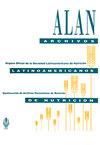Sorghum, germinated millet and chia cookies: development, chemical composition and sensory analysis
IF 0.3
4区 医学
Q4 NUTRITION & DIETETICS
引用次数: 1
Abstract
The objective of this work was to develop cookies using sorghum, germinated millet and chia flours. Four formulations (F) were used: F-sorghum (100% sorghum flour); F-Sorghum + chia (50% sorghum flour and 50% chia flour), F-millet (100% millet flour) and F-millet + chia (50% millet flour and 50% chia flour). The germinated millet flour was submitted to microbiological analysis. All cookies were evaluated in relation to chemical and sensory analyses, according to AOAC and hedonic nine-point scale, respectively. The statistical analysis was performed by the variance analysis and Tukey test at 5% probability. The F-millet formulation showed the least humidity content (4.59 ± 0.25g/100g), while chia containing cookies showed lesser concentrations of carbohydrates (F-sorghum + chia: 44.35 ± 4.34g/100g and F-millet + chia: 41.03 ± 1.40g/100g) and higher ash content (F-sorghum + chia: 3.80 ± 0.02g/100g and F-millet + chia: 3.42 ± 0.24g/100g) and of protein (F-sorghum + chia: 15.38 ± 0.44 g/100g and F-millet + chia: 18.06 ± 0.53 g/100g). The caloric value and the lipids content did not differ among formulations. The sensory analysis had 57 evaluators. The cookies produced with chia and germinated millet had higher rates for flavor, texture and general impression. In general, all tested biscuits had good sensory acceptance and nutritional quality being an alternative to increase the consumption of bioactive compounds and antioxidants.高粱、发芽小米和奇亚饼干的开发、化学成分和感官分析
这项工作的目的是用高粱、发芽的小米和奇亚面粉开发饼干。使用了四种配方(F):F-高粱(100%高粱粉);F高粱+奇亚(50%高粱粉和50%奇亚粉)、F小米(100%小米粉)和F小米+奇亚。发芽的小米粉经过微生物分析。所有饼干都分别根据AOAC和享乐九点量表进行了化学和感官分析评估。通过方差分析和Tukey检验以5%的概率进行统计分析。F-小米配方的水分含量最低(4.59±0.25g/100g),而含有chia的饼干显示出较低的碳水化合物浓度(F-高粱+chia:44.35±4.34g/100g和F-小米+chia:11.03±1.40g/100g)和较高的灰分含量(F-高粱+chia:3.80±0.02g/100g和F-谷子+chia:3.42±0.24g/100g。不同配方的热值和脂质含量没有差异。感官分析有57名评估人员。用奇亚和发芽小米生产的饼干在风味、质地和总体印象方面都有更高的比率。总的来说,所有测试的饼干都有良好的感官接受度和营养质量,这是增加生物活性化合物和抗氧化剂消耗的一种替代方案。
本文章由计算机程序翻译,如有差异,请以英文原文为准。
求助全文
约1分钟内获得全文
求助全文
来源期刊
CiteScore
0.50
自引率
0.00%
发文量
31
期刊介绍:
Archivos Latinoamericanos de Nutrición (ALAN) is the official publication of the Sociedad Latinoamericana de Nutición (SLAN), for the dissemination of knowledge in the fields of food and nutrition, principally throughout the American Hemisphere. Articles in Spanish, English, Portuguese and French are accepted, both from the Society members and from nonmembers, in the following categories: 1. General articles (critical scientific reviews); 2. Research articles (originals); 3. Papers in applied nutrition (analytical results from intervention programs and discussion of reconmendations of practical application), and 4. Letters to Editor (short comments of general interest or about scientific facts and results previously published in Archives).

 求助内容:
求助内容: 应助结果提醒方式:
应助结果提醒方式:


